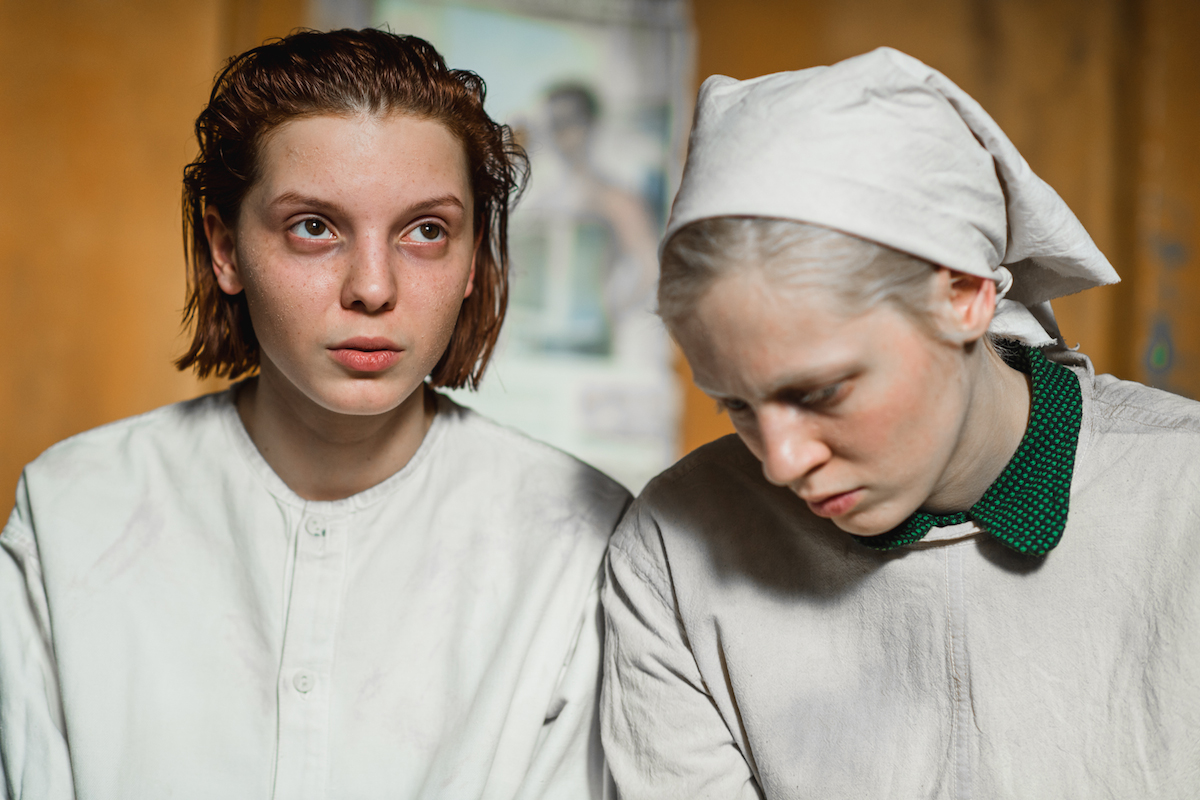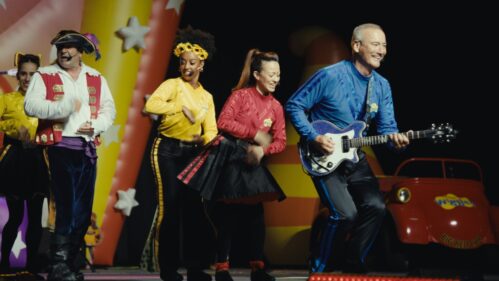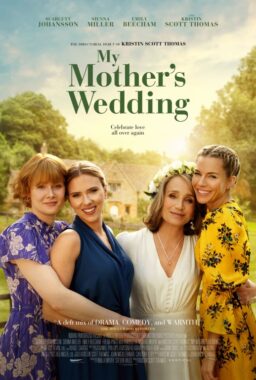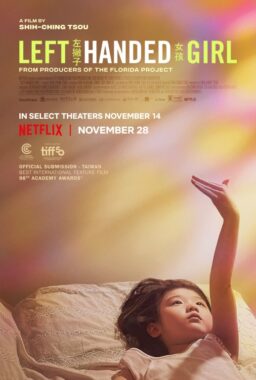Judged by accolades won at Europe’s pre-eminent film festival, Russia’s Kantemir Balagov may well be the world’s most lauded current filmmaker under the age of 30. In 2017, when he was 26, “Closeness,” his debut feature, premiered at Cannes and won an international critics (FIPRESCI) prize. Two years later, his “Beanpole,” which opens in the U.S. this week, took another FIPRESCI award as well as Best Director in the Un Certain Regard section. (Later in the year, the film was short-listed for the Oscars’ Best International Film.)
Promoting “Beanpole” in New York in early January, Balagov seemed to acknowledge his youthfulness with wry, backhanded humor, wearing a large “Star Wars” hoodie (“May the Force Be with You”) throughout his visit and displaying a tattoo on one arm reading HAKUNA MATATA (he admits to an early “Lion King” infatuation). He also allows that his earliest short videos were made in the Tarantino mold. Given these American pop influences, it’s perhaps surprising that the young Russian would be drawing comparisons to such arthouse giants as Bergman, Dreyer and Von Trier. But his rapid ascent has followed an unusual trajectory from the first.
I first encountered him in 2017 in St. Petersburg at a FIPRESCI-sponsored colloquium on current Russian cinema for international critics. One subject of that event was the recent emergence of filmmaking scenes far from the traditional centers of Moscow and St. Petersburg in such unlikely locales as Siberia and North Caucasus. Balagov hails from the latter region (i.e., the Kabardino-Balkar Republic) and owes the beginning of his career to the fortuitous fact that renowned director Alexander Sokurov spent several years teaching a university cinema workshop in Balagov’s hometown of Nalchik. Though not overly impressed with Balagov’s early Tarnantino-esque shorts, Sokurov agreed to take him on as a third-year student, and later stepped in to produce “Closeness.”
As the Cannes critics recognized, that film is an incredibly impressive debut, an intricately wrought, emotionally wrenching drama reflecting the criminal activity and ethnic rivalries that beset North Caucasus in the late ‘90s. Telling of the desperation the town’s small Jewish community faces after a young couple is kidnapped by criminals who demand a staggering ransom, the tale focuses on a tomboyish young woman (a striking, much hailed performance by Darya Zhovnar) who’s pressured to help raise money by abandoning her non-Jewish boyfriend and becoming engaged to a wealthy Jewish boy. The film’s style has a raw, unrelenting, Cassavetes-like realism that shows Balagov’s skill with actors and closeup-centric camera choreography. Though these virtues were praised at Cannes, “Closeness” also drew fire for one scene in which characters watch an actual, stomach-turning videotape of Chechen rebels slowly killing captured Russian soldiers. In St. Petersburg, Balagov defended the scene by saying such tapes did circulate at the time, and were part of the culture he experienced as a teenager.
A masterpiece of stylistic eloquence and emotional acuity, “Beanpole” builds on the strengths of its predecessor with astonishing confidence. Set in Leningrad at the end of World War II (or the Great Patriotic War, as Russians call it), the film’s title is the nickname given Iya (Viktoria Miroshnichenko), a tall, rail-thin blonde who’s working in a hospital caring for traumatized soldiers after serving as an anti-aircraft gunner in the war. The first scene reveals that Iya has a tendency to fall into what seem like frozen trances, a condition that adds a tragic dimension to her reunion with her wartime cohort Masha (Vasilisa Perelygina), who went all the way to Berlin with Russia’s forces. Though Masha soon falls into a romance with a diffident young man named Sasha (Igor Shirokov), and the two women are surrounded by the hospital’s patients and doctors as well the hustle and bustle of a vividly recreated 1945 Leningrad, Balagov maintains a close focus on the ever-evolving relationship between Iya and Masha, an interior drama built less on words than on looks and silences (the comparisons to Bergman’s “Persona” are inevitable), and an extraordinary visual approach that includes emphasis on greens and reds.
You become so enmeshed with these characters, as with the heroine of “Closeness,” that it occurred to me that both of Balagov’s films could be titled “Intimacy” – though in the case of “Beanpole” that perhaps should be expanded to “Intimacy Following the Trauma of War.” Speaking to an audience at New York’s Film Forum in early January, Balagov – charismatic, modest, thoughtful — revealed two inspirations for the film. One was a Robert Capa photograph of two women dancing together in Moscow after World War II. The other was a book, “The Unwomanly Face of War,” an oral history of Russian women in the war by Svetlana Alexievich, winner of the 2015 Nobel Prize in Literature.

When Balagov and I spoke the next day at Film Forum, much of the conversation was in English, though we were assisted at times by the expertise of translator Sasha Korbut.
What was your upbringing in North Caucasus like, the place and your family?
I grew up in an average family, not rich, not poor. There was no relation at all to cinema in our family. I was about 12 years old when my parents got divorced, and that was like a turning point in my life. As a child I had to make a choice as to whether I wanted to live with my father or my mother. I chose to live with my mother and sister. I think that’s a sign of why the first two films I made were dedicated to women.
I feel like I had a pretty tough childhood. I couldn’t understand my mother, I couldn’t understand her needs, her desire to realize herself as a woman. At that time, when I was in seventh grade, I had pretty good grades in school, but I had to deal with things around me, like drugs. Nalchik where I grew up had that kind of scene.
We had a cinema in my ‘hood, called Friendship, and the first film I watched there was “Naked Gun.” (Laughter)
You’ve said that you really got interested in cinema after you heard that Alexander Sokurov was teaching in a school near you. How did that happen?
As I’ve said, before that I made some YouTube series, like ten series of five to ten minutes each. Then a friend of mine told me that Sokurov had opened his studio in Nalchik, and he’d already been there four years. But I didn’t know who Sokurov was because I didn’t watch this kind of movie. I just Googled him and I saw he had won the Venice Film Festival. I started to watch his movies, and I realized I wanted to be a student of his. So we set up a meeting and he said, “You can be a student of mine if you don’t use violence or profanity.” He didn’t want me to aestheticize violence.
So you didn’t tell him you like Tarantino?
No, he knew! That’s why he said it. He saw my YouTube series and he saw the Tarantino influence very clearly!
What is Sokurov like as a person and as a teacher?
Well, he has an excellent sense of humor. You can’t tell this too much from watching his movies. Before I knew him well, I saw his films and I thought they were serious arthouse films. But later I thought that they were all comedies, and you just have to know him to see that. I look at him and I think, “This person is out of space and out of time, he projects such a massive amount of energy.” I feel very small next to him.
You have said you feel like you developed greatly under him as a person, not just as a filmmaker. What were the key things you learned from him?
Most importantly, [love of] literature. Before him, I’d read maybe one or two books, unfortunately. But Sokurov said it’s more important for a director to read books than to watch films. Before I started they gave us a list of books to read. I had to keep up with that list, and what I realized later was that at this time I started to form myself, to take shape as a person. Before that, I was just kind of going with the flow, living an unconscious type of life.
What book impressed you the most?
I think it was “Chevengur” by Andrei Platonov [1899-1951, he has been called “Russia’s greatest 20th-century prose stylist”]. After that I fell in love with this writer – the language, the characters, they were just amazing.
In studying film technique under Sokurov, what did you learn?
First and foremost, he prohibited us from watching his own films, from analyzing and criticizing them. I think this was because he didn’t want to turn out twelve mini-Sokurovs. He wanted to have twelve students that shaped their own vision. If you look at our student work., the notes he gave us were pointing us in a professional direction, an artful direction, but they were not trying to impose his own vision on us.
Did you say that at the school, you worked with actors?
No, we were the actors. We had an acting school where we were the actors. It was really tough.
Why was it tough you on you?
Because I’m a closed person, I’m an introvert. And coming on the stage, trying to play a character, that was tough. But I also think it had a good influence on me, because it helped me to open up a bit.
Did it also teach you about what actors go through?
Yeah, yeah. All the tools you need, the layers of acting. Of course. But I was a terrible actor! (Laughter)

How did you come to make “Closeness”? Because it’s not at all a student film. It’s very accomplished, but it’s also on pretty big scale.
Well, the story about kidnappings in the ‘90s I heard from my father. But his story was too criminal for me, it was like gunshots, killings, etc. It was from the point of view of the kidnappers, not the family. I was curious about family relationships; I think I’m still curious about that theme. So I found the scriptwriter [Anton Yarush] through Facebook and we started to work on the story. The first question we had to ask was, Is it right to ask your child to sacrifice himself, even if the sacrifice is for another family member, for example a brother? And of course it was about traditions and the kind of conservatism we have in the Caucasus.
Once we had a script, I went to Russia’s equivalent of imdb and made a list of producers who had won prizes at international film festivals. I started writing to these producers. I got back some very nice rejections. So I decided to move to Moscow, where my sister was living, and started setting up personal meetings with producers. I was thinking, I’m an alumnus of Sokurov, now everybody wants me. (Laughter) I got a lot of rejections and the reasons people gave me were that no one would want to go to the theater to see a film about North Caucasus, or a story that takes place in the ‘90s. At that moment, Alexander Sokurov wrote me a letter saying we are willing to produce your film, so I went to St. Petersburg and we started shooting. He has his own production company and helped four of his students make their films.
The family in “Closeness” is Jewish. Is your family Jewish?
No. My family is Kabardian [an ethnic group that contains both Muslims and Christians] but I had a relationship with a Jewish girl and through that came to know the Jewish community. In the film, where the girl’s family forbids her to have a relationship with a boy because he’s not Jewish – that’s familiar to me.
In many ways, the film offers kind of a harsh view of life in this place. What kind of reaction did it get there?
Well, I think my films always get a kind of a 50/50 reaction (in Russia). Some people there really liked the film. To be honest, I expected that everyone would hate it. But no. Some people said, this is exactly the way it was. Others said, no, there were no kidnappings in North Caucasus then, that’s b.s., it was a great time to be alive. (Laughter) So it was 50-50.
At Cannes, the film was controversial because of that one scene.
Yes, my love Uma Thurman got angry! (Laughter) There was a big scene at the festival about it. Personally, I was uncomfortable at Cannes that first time because it’s a big festival and there were a lot of people I didn’t know. But with “Beanpole” I was much more comfortable because there were people I knew and it became important to me to work with people who had helped me on my first film, people who really believed in me.
Let’s talk about how “Beanpole” got started.
Well, in 2015, when I was studying with Sokurov, I read this book “The Unwomanly Face of War.” From that moment, I knew I wanted to make a film about that subject. After we premiered “Closeness” in Cannes, I started writing some short synopses of scenes. I wrote to (producer Alexander) Rodnyansky saying I’d like to make a film on this theme, and I wanted to make it with him because he is the number one producer in Russia. I knew that only he could make this film possible without asking the government’s support.
So he responded to you positively?
Yes, we were in Telluride together because (Andrei Zvagintsev’s Rodnyansky-produced) “Loveless” was there and “Closeness” was too, so we had a chat. At the beginning he thought the film should be about modern days, but as we talked he realized that the value of the story lies in what it says about those older times, for many reasons, including that people at that time were hoping for a miracle.
Besides “The Unwomanly Face of War,” what drew you to the post-WWII period, what made you want to make a film about it?
I was curious not necessarily about that period. I was curious about the aftermath of war. Right now I’m curious about the aftermath of the Chechen war. In such periods, you can see the quintessence of human nature. There are no absolutes. You can be a hero, you can be a coward. I really like it when my heroes act abnormally, immorally. At the same time, even if they act amorally, throughout the film I express compassion towards them, I understand them, why they are acting like that. And this is really important. This I took from literature.
Where did you get the device of having Iya freeze? Was that epilepsy, or something similar to epilepsy?
To be honest, it’s not a documentary thing. It was like a fiction. It’s a way of escaping for her, so that she can be in her own world.
So this was something you came up with yourself, rather than finding it in a medical textbook, say?
Yes, I came up with it, with the scriptwriter [Alexander Terekhov].
Talk about how World War II is perceived in Russia now. It had such a huge impact on your country in the last century. Yet you’re far too young to remember it. Maybe your grandparents’ generation lived through it, and there have been two generations since then. How is it regarded now, among people of different ages?
Now the perception of the war is more mythical. Speaking from my own life, when I was a kid and went to these parades on May 9 commemorating the end of the war, I looked at it as a huge celebration, as something festive. And now after reading “The Unwomanly Face of War,” I realize it shouldn’t be just a celebration; it’s important to acknowledge the trauma of that time. When I moved to St. Petersburg and went to parades, I couldn’t believe people were getting really drunk and shouting things like, “We can do it again! Let’s go to Berlin!” I couldn’t understand parents who were putting military uniforms on their kids.
So in the mythic version, there’s no suffering.
Yes, and no sacrifices. There’s no human side. It’s like, We are gods! Like Greek mythology.

You said you found the two actresses who play the film’s lead roles in the first day of casting. That’s amazing, right?
Yes, it was amazing. Our casting director, Vladimir Golov, worked with me on “Closeness,” and he’s like my soul mate. He understands me, he understands the story. I think it’s due to him that we found these two on the first day. It was incredible. I had a conversation with them. I wanted to find some trauma in them, and after the conversation we had some rehearsals and the girls received an excerpt from the book [“The Unwomanly Face of War”]. For me the most important thing was that they could go through these emotions.
And these were not professional actresses, right?
Right. They were students. Studying acting.
Did they know each other before meeting at the casting?
No. And it’s funny. I tried another actress to play Masha. And it didn’t work. There was no chemistry between them. There was only chemistry with Vasilisa.
How did that chemistry evolve during the shooting of the film? Did they get closer personally, and did that affect the storytelling?
Yes. We moved them to St. Petersburg two months before the shooting. Because we did a pre-shoot and I wanted them to be a part of that. They shared an apartment. That was intentional because I wanted them to get closer, even if that meant they started to irritate or annoy each other. That could benefit the film.
So much of what happens between them in the film is conveyed by looks rather than words. How did you get them to do that?
I think it’s because I really love intimacy in films. Yesterday someone said maybe it’s the influence of Dreyer, like in “The Passion of Joan of Arc.” I hadn’t thought about that, but in that film the impression the faces make is so strong. To me it’s really important what the faces can communicate that words cannot. Because words come more from our intellect, our mind, where emotions come more through the facial expressions.
But how did you get them to do that?
They are good actresses! (Laughter) No actually, it wasn’t easy. We tried to find the right intonation of voice, of body language. But they are both modern girls, so that’s why we moved them to St. Petersburg. I didn’t want them to go to parties or something like that. I wanted them to be focused, to read a lot, to watch some movies, and not eat much. (Laughter)
You mentioned Dreyer. But you said last night that Bergman wasn’t on your mind, you hadn’t seen much Bergman, right?
No, I had seen his films while working on “Beanpole” but it wasn’t a reference.
Were there films that were references for you?
Yes. “My Friend Ivan Lapshin.” “Wings,” by Larisa Shepitko. “The Cranes Are Flying,” of course. “Breaking the Waves,” which was a reference for “Closeness” too. “Dancing in the Dark,” in some ways.
One thing that was interesting to me was that the film takes place at a certain point in history. Yet there’s no reference to the Communist Party, we don’t see any red stars, we don’t hear about Comrade Stalin or anything that’s going on in the world. Why is that?
It was intentional. Our art director was always insisting on putting in a bust of Stalin, saying it’s impossible not to have it. But cinema is a tool of immortality and for me this person doesn’t deserve immortality.
Good answer. Let’s talk about the visual style of the film, and especially the color palette. Many movies about this period use black and white, because that conjures up what we know through films of the period. Why did you decide to use color?
In doing research into the period, I found out that people tried to escape the gray reality of the period through using colors. That became really interesting to me. I wanted to make a film about the young people of those days – a film by young people, for young people. That’s one reason for using color, though not the main reason.
The cinematographer [Kseniya Serada] is a woman?
Yes, she was 24 years old when we made the film.
Her work is amazing. How did you choose her?
It was like an accident. When we found her she already had a gig. But luckily for us it was canceled. From the first time we met I decided this was the person I wanted to work with. I think she brought something important to the film that I didn’t expect. I don’t think it’s because she’s female and I’m a male, because I really think cinema and love and art should have no gender. She brought something as a person, as a human being, because if you know her well, she’s amazing.
How did you and she decide on the color palette for the film? Because it’s very distinctive, and I think it has a lot to do with why the film is so appealing and visually engaging.
It had to do with Dutch painters, like Vermeer, “Girl with a Pearl Earring.” Also I saw some photos and pictures with this kind of color palette and I really found it interesting for the story because it’s like the battle of rust against hope and life – the red and green.
Let’s talk about the very striking scene late in the film where Masha meets Sasha’s well-to-do parents, because this is the place where class differences come in. Why did you decide to introduce this element at that point in the story?
First of all, this was something that existed then. One thing I discussed with my co-writer was that we didn’t want to judge these parents, we wanted to understand them. And there’s a statement the mother makes where she says, “You don’t know what we’ve gone through.”
That’s right. She seems to be equating her and her class’ experiences with those of Masha and Iya. And that may have some validity, yet their experiences must have been very different too.
Yeah, but everybody suffered.
You’ve said the reaction to “Beanpole” in Russia has been 50/50. Why the negative reaction? Did people read it as a love story between two women – was it an anti-gay thing?
Yeah, the most critical reactions called it “two lesbians in World War II.” I was like, okay, if you think so, alright, I can do nothing about that. But as I said, love has no gender. And it’s like this photo of Robert Capa of the two women dancing at the end of World War II: it’s not about two women in love, it’s about human relations. It’s more than a gender love.
Header caption: Viktoria Miroshnichenko and Vasilisa Perelygina in a scene from “Beanpole,” courtesy Kino Lorber.












